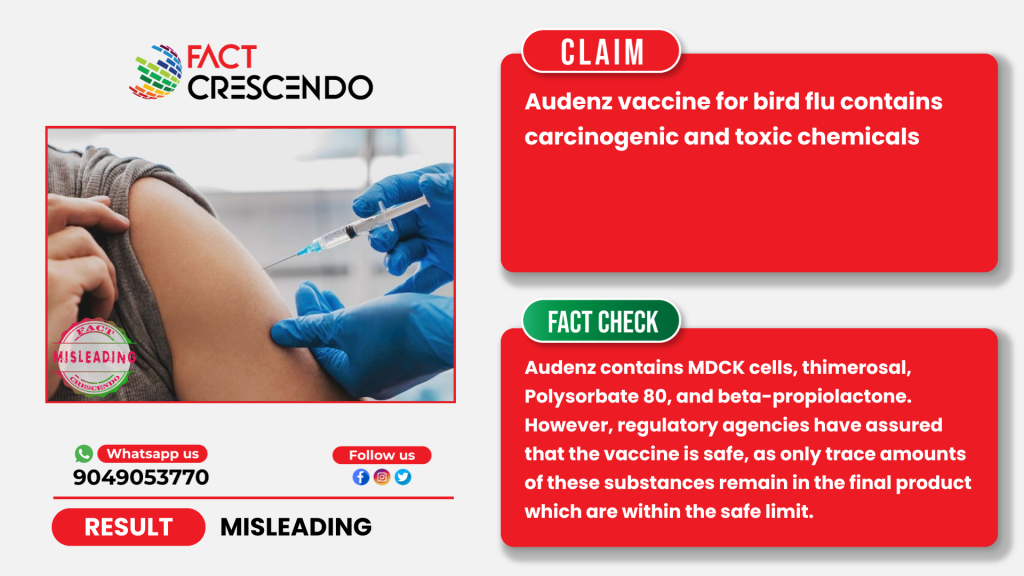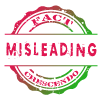
Social media users are raising concern over the use of Audenz vaccine for bird flu. Users are claiming that Audenz vaccine contains MDCK cells (a dog’s kidney DNA) along with other substance like thimerosal, Polysorbate 80 and beta-propiolactone which re extremely toxic, tumorigenic, genotoxic and carcinogenic.
However, Fact Crescendo found the claim to be misleading. Although, Audenz contains MDCK cells, thimerosal, Polysorbate 80 and beta-propiolactone, but regulatory agencies assured that the vaccine is safe and tiny amount of these substance are traced which falls within the safe limit.
Fact Check-
MDCK Cells:
Cell culture methods, such as using MDCK-33016PF cells, help produce seasonal influenza vaccines and provide flexibility for handling flu pandemics. To ensure safety, the vaccine production process includes multiple steps to eliminate any residual cells, DNA, and potential viruses. The residual MDCK cell DNA is kept to very low levels (≤10 ng per dose) and broken down into small pieces, while chemicals like ß-propiolactone inactivate the virus, further reducing risks. Advanced testing confirms the absence of harmful viruses or DNA, and the entire manufacturing process is validated to remove and inactivate viruses, ensuring the vaccine is safe and the risk of contamination is effectively zero.
As per FDA, AUDENZ is a sterile injectable vaccine given as a shot in the muscle. It is an inactivated, single-strain influenza vaccine made using Madin Darby Canine Kidney (MDCK) cells, which are grown in a liquid culture. The virus used in the vaccine is inactivated with a chemical called ß-propiolactone, broken apart using a detergent, and then purified through several steps. The process for making the influenza antigen in AUDENZ is the same as the one used for FLUCELVAX and FLUCELVAX QUADRIVALENT, which are seasonal flu vaccines without added immune boosters approved for use in the United States.
Further we found the process of manufacturing of the flu vaccine based on cell culture. According to CDC, cell culture-based flu vaccines, approved by the FDA in 2012, are made using mammalian cells instead of chicken eggs. The process involves growing flu viruses in mammalian cells to create vaccine strains which are then replicated in cell cultures. The virus is collected, purified, inactivated, and tested before FDA approval and release.
Thimerosal:
AUDENZ 5 mL multi-dose vials contain thimerosal, a mercury derivative, added as a preservative. Each 0.5 mL dose from the multi-dose vial contains 25 mcg mercury.
According to FDA, Thimerosal is used in some vaccines to prevent the growth of dangerous microbes. It is used as a preservative in multi-dose vials of flu vaccines, and in two other childhood vaccines, it is used during the manufacturing process and removed later. The preservative, thimerosal, prevents contamination in the multi-dose vial when individual doses are drawn from it. Thimerosal, which is used during manufacturing process is later removed and only a tiny mount is traced in the final product.
Another report says that Thimerosal is about 50% mercury by weight and breaks down into ethylmercury and thiosalicylate. Ethylmercury has been studied extensively and is safe in the small amounts used in vaccines.
Thimerosal is highly effective as a preservative, meeting safety standards and preventing the growth of bacteria and fungi in concentrations as low as 0.01%. A dose of vaccine with 0.01% thimerosal contains about the same mercury as a small can of tuna. It has a long history of safe use, with only minor injection site reactions reported.
According to CDC, Measles, mumps, and rubella (MMR) vaccines, as well as vaccines for chickenpox, inactivated polio (IPV), and pneumococcal disease, have never contained thimerosal. Flu vaccines, however, are available in two versions: some contain thimerosal as a preservative for multi-dose vials, while others are thimerosal-free. Thimerosal use in medical products has a record of being very safe. Data from many studies show no evidence of harm caused by the low doses of thimerosal in vaccines. The most common side-effects of thimerosal in vaccines are minor reactions like redness and swelling at the injection site. Although rare, some people may be allergic to thimerosal.
Polysorbate 80:
Polysorbate 80, an emulsifier commonly used in medicines and vaccines to stabilize proteins, is generally safe at the low doses used in vaccines, such as ≤1.2 mg/kg. However, higher doses or rapid injection rates can cause certain effects, including rare allergic reactions, temporary cardiovascular effects like low blood pressure, and liver enzyme elevation in extreme cases. Slow infusion rates are recommended to minimize risks. Additionally, polysorbate metabolism may release sorbitol, which could pose a theoretical risk for individuals with hereditary fructose intolerance (HFI), though this has not been confirmed as a significant issue. The low levels of polysorbate 80 in vaccines are well below thresholds associated with adverse effects, making it safe for its intended use, while further research is encouraged to study its effects at higher doses in other medical applications.
Polysorbate 80 is commonly used in vaccines as an emulsifier to help ingredients mix together and maintain stability. Regulatory agencies, including the U.S. Food and Drug Administration (FDA), recognize its use in vaccines as safe.
Beta-propiolactone:
Beta-propiolactone (BPL) is classified as “reasonably anticipated to be a human carcinogen” based on evidence from studies in animals. In its pure form, BPL is recognized for its carcinogenic and genotoxic properties. The International Agency for Research on Cancer (IARC) has classified BPL as a Group 2B carcinogen, indicating it is possibly carcinogenic to humans.
In vaccines, BPL is used to inactivate viruses. Due to its highly reactive nature, BPL rapidly breaks down into harmless byproducts, such as beta-hydroxypropionic acid. The vaccine manufacturing process includes purification steps to ensure the residual amount of BPL is below detectable or harmful levels.
The FDA and other regulatory agencies carefully test vaccines to make sure they are safe. Even though BPL can be harmful in its pure form, it is used in a controlled way during vaccine production and completely removed afterward. This makes vaccines like AUDENZ safe to use.
In studies from the 1950s and 1960s, nearly 1,000 people received blood plasma treated with beta-propiolactone at Henry Ford Hospital. Some also had plasma treated with ultraviolet radiation. Most patients received only a few transfusions, while a small number had many more. Over 10 years of monitoring, with follow-ups ranging from 6 months to 5 years, no long-term toxic effects were found in the patients.
Conclusion:
Fact Crescendo found the claim to be misleading. Although, Audenz contains MDCK cells, thimerosal, Polysorbate 80 and beta-propiolactone, but regulatory agencies assured that the vaccine is safe and tiny amount of these substance are traced which falls within the safe limit.

Title:Does the Audenz Bird Flu Vaccine Use MDCK Cells and Other Toxic Chemicals? Regulatory Agencies Assure Safety.
Fact Check By: Siddharth SahuResult: Misleading


